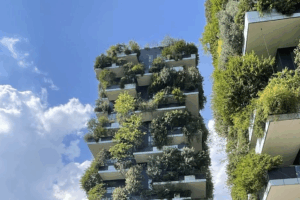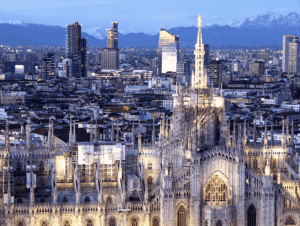Miami presents sophisticated investors with an extraordinary arbitrage opportunity. While traditional metrics suggest a cooling market—inventory has reached 9.7 months of supply, the highest nationally—the luxury segment operates in an entirely different dimension, with ultra-prime properties commanding record premiums and multiple offers becoming commonplace once again.
This divergence isn’t a market anomaly; it’s a structural realignment that creates precisely calibrated entry points for international capital. The data tells a compelling story: in September alone, Palm Beach County recorded a 497.7 percent surge in new signed contracts, while Miami-Dade’s luxury single-family homes priced above $3,000 per square foot saw sales increase by 115 percent year-over-year. These aren’t speculative bubbles but fundamental shifts in how global wealth engages with premier American real estate.
For international investors familiar with markets like Milan’s Porta Nuova or Monaco’s waterfront, Miami’s current dynamics offer recognizable patterns with distinctly American advantages. The region is on track to complete 426 ultra-luxury transactions above $10 million this year, approaching the 444-unit record set in 2021. Yet unlike that pandemic-driven surge, today’s demand reflects structural factors: sustained wealth migration, favorable tax frameworks, and Miami’s emergence as a genuine global city rather than merely a seasonal destination.
The market’s bifurcation creates extraordinary opportunities for sophisticated buyers. While median prices in the broader market have declined 7.8 percent to $590,000, luxury condominiums have crossed the $1,000 per square foot threshold for the first time, reaching $1,027 in the second quarter. This pricing divergence allows astute investors to acquire premium properties at advantageous relative valuations while the broader market psychology remains cautious.
Recent Federal Reserve rate adjustments have added another dimension to the opportunity matrix. With mortgage rates declining to approximately 6.5 percent and further reductions anticipated, leverage strategies that were previously uneconomical now offer compelling returns. International buyers, particularly those accustomed to European financing costs, will find American mortgage products increasingly attractive for optimizing capital deployment.
The surge in September transactions—Miami-Dade saw a 118.3 percent increase in single-family home contracts, while condominium sales jumped 193.4 percent—signals the market’s responsiveness to improved financing conditions. Yet these figures mask the more nuanced reality: luxury buyers, operating predominantly with cash, are capturing properties before traditional buyers can mobilize. This speed advantage becomes particularly pronounced in competitive situations where multiple offers emerge.
What distinguishes Miami’s current luxury boom from previous cycles is the sophistication of the product being delivered. Developers have evolved beyond mere opulence to create genuinely differentiated living experiences. The Bentley Residences, with units starting at $7.5 million, exemplify this evolution—private pools, integrated automotive galleries, and concierge services that rival five-star hospitality brands. Half the units have already sold with 50 percent deposits, demonstrating buyer conviction that transcends typical market sentiment.
This branded residence phenomenon represents a fundamental shift in luxury real estate development. Properties bearing automotive or fashion house imprimaturs aren’t simply leveraging logos; they’re delivering curated lifestyles that resonate with global ultra-high-net-worth individuals. For European investors familiar with branded hospitality residences in destinations like Lake Como or the Côte d’Azur, these Miami properties offer comparable prestige with superior appreciation potential.
The insurance and construction cost challenges that dominate mainstream market discourse actually strengthen the luxury segment’s competitive moat. When insurance costs for a single development reach $42 million, as with the Bentley project, only developers with exceptional capitalization and execution capabilities can deliver. This barrier to entry ensures sustained scarcity in the ultra-prime segment, protecting values even as broader inventory accumulates.
International buyers should particularly note Miami-Dade’s remarkable statistics: 28 single-family home sales exceeding $3,000 per square foot in the first seven months of this year, compared to zero pre-pandemic. This isn’t price inflation but genuine market deepening, reflecting Miami’s evolution into a truly global wealth hub comparable to Singapore, Dubai, or Geneva.
The personalization revolution transforming luxury construction offers additional value creation avenues. Custom features, from hidden door systems to fully integrated smart home ecosystems, allow properties to command premiums well beyond traditional comparable sales. This trend mirrors what we observe in Milan’s luxury renovations, where bespoke design solutions can add 30 to 40 percent to base valuations.
For portfolio diversification, Miami offers compelling advantages over traditional safe-haven markets. Unlike London or Geneva, where luxury segments have matured and appreciation rates have moderated, Miami combines emerging market dynamism with developed market stability. The absence of state income tax, combined with Florida’s business-friendly environment, creates sustainable demand drivers beyond purely residential considerations.
The current inventory dynamics in the broader market—with sellers outnumbering buyers significantly—actually benefit luxury segment investors. Developers and sellers of premium properties can negotiate advantageous terms with contractors, materials suppliers, and service providers who need steady business. This cost advantage translates directly to buyer value, particularly for those able to close quickly with cash.
Looking forward, Miami’s trajectory appears increasingly differentiated from both national housing trends and other luxury markets globally. The combination of domestic wealth migration, international buyer interest, and limited new ultra-prime supply creates a compelling multi-year appreciation thesis. The September sales surge, rather than representing a temporary spike, likely signals the beginning of a sustained upward cycle in the luxury segment.
For Columbus International’s clients, Miami offers multiple strategic entry vectors. Direct acquisition of completed luxury residences provides immediate positioning in a appreciating market. Pre-construction purchases in branded developments offer enhanced returns through early-stage pricing. Even selective opportunities in the softening mid-market segment could yield exceptional returns as the market rebalances.
The key insight for international investors is recognizing that Miami’s apparent market contradiction—simultaneous softening and strengthening—actually represents a generational reallocation of value toward quality, scarcity, and differentiation. In this environment, sophisticated capital doesn’t just preserve wealth; it captures the premium that accrues to those who understand that luxury real estate has become its own asset class, operating independently of traditional residential market dynamics.
Miami isn’t simply weathering a market transition; it’s establishing itself as a permanent fixture in the global luxury real estate constellation. For those with the vision and capital to participate, the current moment offers entry into a market that has fundamentally redefined what premium urban living means in the twenty-first century.
Richard Tayar is the founder of Columbus International, an international real estate firm bridging markets between the United States and Italy, with focus on New York, Milan, Tuscany, and Miami.



